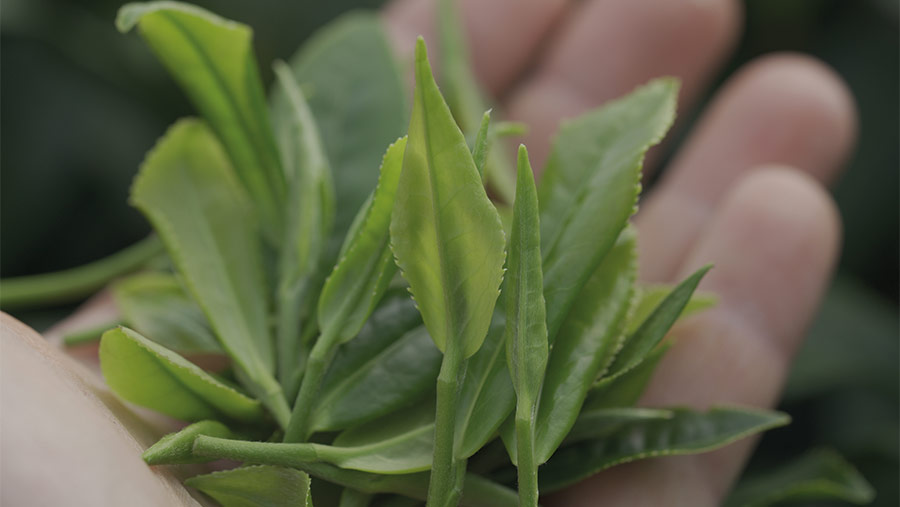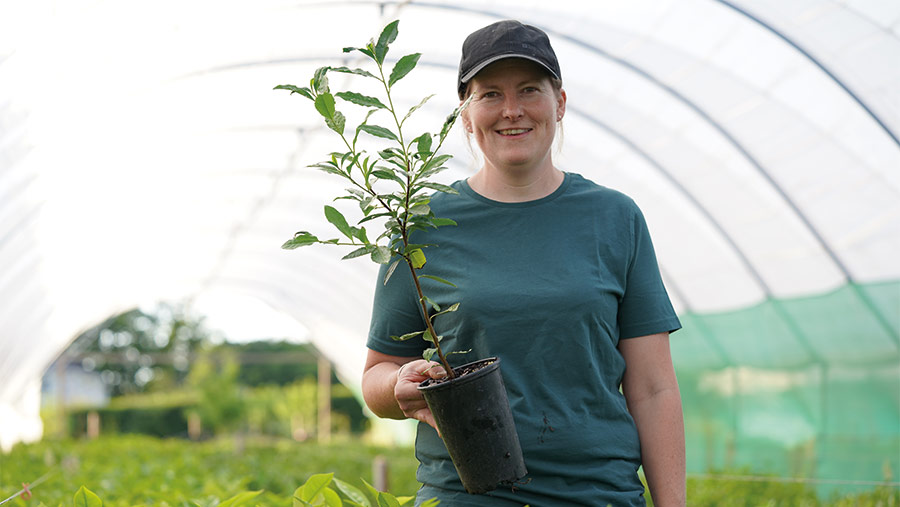Horticulture business has ambitions for tea diversification
 © Supplied by Lucy George
© Supplied by Lucy George Peterson Tea in the Vale of Glamorgan was the brainchild of Lucy George, who was looking for a new enterprise for the small family farm, which had traditionally focused on growing soft fruit.
The first tea leaves were picked in 2019, yielding just a few hundred grams of tea, but the endeavour is now expanding, with products sold via its website and in a few shops.
It’s even stocked in London retailer Fortnum & Mason.
See also: Farmers Weekly Awards 2022 – Diversification Farmer of the Year
“Most of our plants haven’t started cropping yet, because there’s a long lead time between planting and picking,” explains Lucy.
“Right now, there’s probably not even 1,000sq m fully mature and cropping, but I’m aiming to ultimately grow about five acres.”
Some will be in polytunnels and some outside on south-facing, lightly sloping and fairly sheltered land.
How it started
The former ag college student hit on the idea of growing tea because of its attributes as a unique high-value, non-perishable lightweight product.
“We’d been growing soft fruit, making ice cream and running a farm shop, but it was just too much work. So I’d been trying to come up with an idea for a business that I could run on my own.
“I wanted one that could generate a more stable income throughout the year, was less weather dependent and easier in terms of distribution.”
Lucy admits that preferring PG Tips to other brands was the extent of her previous knowledge. “I didn’t really know anything about tea initially, in terms of how it was grown or even where it was grown.”
She took a “deep dive” into research, exploring agronomy and markets and, convinced she was onto a good idea, was soon ready to order seeds

Lucy in one of the tea polytunnels © Suppied by Lucy George
Experimentation
“We imported them from ex-Soviet Georgia. We chose that part of the world because it had more extremes of climate than some areas, so we figured the plants would be more likely to survive.”
Lucy tried nearly 400 seeds that first year and, even though germination was good, most died as soon as they were planted outside.
Undeterred, she ordered another 20,000 the following year – and repeated the process every year for next few years.
“It was a massive programme of germinating as many as we could, selecting the strongest, then planting them out.”
According to Lucy, it takes four to five years from planting for tea to mature into good-sized bushes with a “table-top” that can withstand regular plucking.
“There were times when I was pulling my hair out getting the plants to cropping stage – but, of course, that’s only half the battle. I then had to actually make the tea!”
It has similarities to winemaking or cheesemaking, she says.
“There is some science and set processes involved, but it’s a lot of intuition. It’s all about the senses – smell and taste, and feel and sight. People in China and India spend a lifetime learning this.
“I learned through trial and error. I did an obsessive amount of research – lots of Googling, reading and time on YouTube.
“I also did courses and work with the UK Tea Academy, which have given me great information on growing tea and all the different cultures associated with it.
“It was an opportunity to taste teas from all over the world, made by different processes, and understand what I was aiming for.
“There are so many dynamic factors involved in growing tea. That’s part of the excitement – you will always have something unique.
“Even if someone else started growing it five miles away from me, what we were both producing would be entirely different. As in the wine sector, the word ‘terroir’ applies.”
Processing
Lucy imported some small-scale equipment from China and Japan for the processing.
This involves withering the leaf through a chemical and a physical process to lose the moisture, then rolling (using either a machine or by hand).
The broken leaf is then allowed to come into contact with air that’s warm and humid enough to fully oxidise the leaf. It’s then dried in a rotating air dryer.
“Once it’s rested and relaxed, it’s good to go,” she says.
“I’m not making any money at the moment, but it’s not a hobby – it has to ultimately be a commercial enterprise.”
It certainly has potential, she believes. While most people haven’t heard of tea being grown in the UK (Lucy thinks she’s the only grower in Wales), consumers are keen to buy British, buy local and reduce their food miles.
“It’s a completely different taste profile to tea from abroad, too. Our teas will be as nature intended – rich in diversity of flavour and aromas, full of character but always changing and completely unique.
“The challenge is to make it price-point accessible when the odds are stacked against us in terms of unit cost. Part of the problem is wages – labour costs in the UK are absolutely prohibitive for tea.
“My plan is to continue producing only unblended teas, but increase the volumes and add value through events such as open days and courses.
“I’m also still making ice cream and growing fruit, some of which is alongside the tea to act as shelterbelts in an agroforestry-type system. I’ve planted hundreds of Sichuan pepper trees which provide shelter and shade,” she says.
“Like a lot of farmers, I run on tea. I’m also constantly tasting different types to hone my own instincts. That said, I still have a cup of PG Tips every morning!”
Find out more about Peterston Tea on its website
